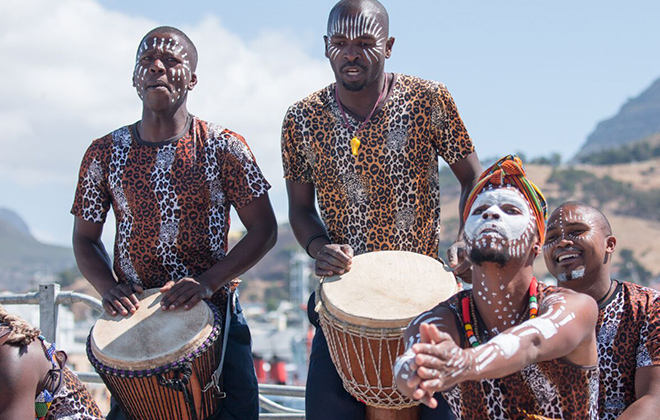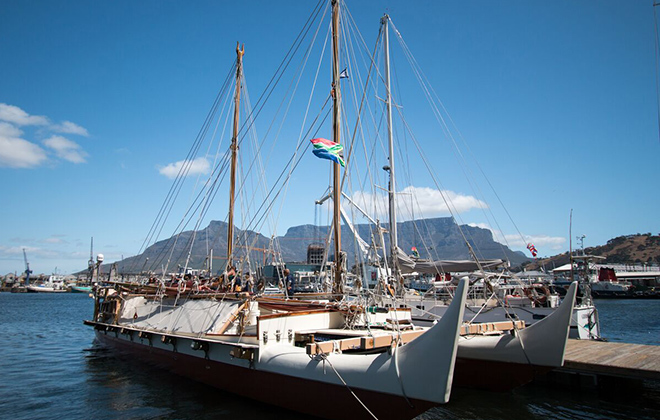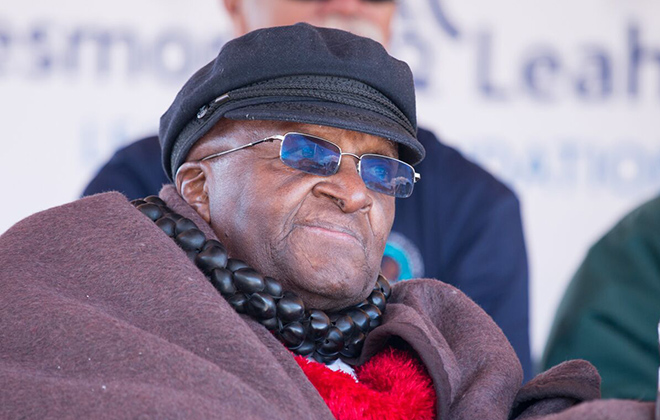South Africa fetes Hokule’a

A ceremony of friendship was held Saturday in Cape Town to welcome and celebrate the arrival of the Hokule‘a. The ceremony featured traditional South African performances


A ceremony of friendship was held Saturday in Cape Town to welcome and celebrate the arrival of the Hokule‘a. Archbishop Desmond Tutu



CAPE TOWN, South Africa >> As the world reeled Saturday from violence in Paris, an unlikely mix of Hawaiian voyagers, South Africans and an acclaimed Nobel Peace Prize winner celebrated all they had in common despite living on opposite sides of the earth.
Archbishop Emeritus Desmond Tutu; his daughter, the Rev. Mpho Tutu; U.S. Ambassador Patrick Gaspard; and some 200 others warmly welcomed Hokule‘a and its crew to Cape Town after some of the most dangerous, challenging and exhausting sailing the Hawaiian voyaging canoe has ever endured.
This bustling African city on the southern edge of the world had likely never seen a double-hulled Polynesian sailing vessel until captain and master navigator Nainoa Thompson and his weary crew steered Hokule‘a into town last week, capping their frigid 41-day haul from Mauritius. They had wrapped up the latest leg of the canoe’s Malama Honua (“Care for the Earth”) worldwide voyage.

Tutu, the Nobel Peace Prize-winning advocate for human rights who helped shine a spotlight on and ultimately topple South Africa’s brutal apartheid system, cheerfully waved to the canoe Saturday as it was towed into the Victoria & Alfred Waterfront for the ceremony.
Crews of the canoe and its escort vessel, the Gershon II, disembarked amid a colorful mix of cheers and chants — of both island and African origin. Hawaiian and Zulu dancers took turns performing routines at the event, with Cape Town’s scenic, rocky Table Mountain, a 3,500-foot-tall mesa, towering behind the display.
Don't miss out on what's happening!
Stay in touch with breaking news, as it happens, conveniently in your email inbox. It's FREE!
Hokule‘a is now almost exactly halfway around the world from Hawaii, traveling from one of the last points of human expansion on the planet to one of the first, in Africa.
“You have come from the newest civilization to the cradle of humanity. You have journeyed home,” Mpho Tutu told the crew Saturday. “The voyage of the Hokule‘a reconnects us to each other on a primal level.”
Kalepa Baybayan, a master navigator and captain also aboard the canoe on this leg, agreed. “We have come full circle,” he told the crowd. “At the end of the journey, you always arrive back at the beginning.”
Desmond Tutu, meanwhile, sat silently and often smiled under a shaded tarp supported by bamboo poles. He appeared to listen intently to the speakers, occasionally laughing out loud. As the event concluded he danced along with about two dozen children in the Isivungu Vungu youth band as they played music.
The ceremony represented a bookend of sorts to the 84-year-old retired archbishop’s 2012 visit to Hawaii, in which Tutu blessed and briefly sailed on Hokule‘a.
“You gave us the blessings and that was the key that allowed us to be able to come around the world” to South Africa, Thompson told Tutu on Saturday.
Toward the ceremony’s end, Billy Richards, a member of the original 1976 Hokule‘a voyage who served as a captain on the most recent leg, gave Tutu a kahili — a feathered symbol of Hawaiian royalty usually reserved for alii, or chiefs.
A dozen students total from Kamehameha Schools and Halau Ku Mana Charter School performed the traditional Hawaiian song and dance.
Despite the celebration, Mpho Tutu called for a moment of silence at the event to remember the victims of the Paris terrorist attacks, in which nearly 130 people were killed. The jihadist group Islamic State has claimed responsibility.
After the ceremony, as she reflected on the new kinship between the Hawaii group and South Africans who attended, Tutu said she believed that in a world increasingly dominated by social media and short attention spans, “we don’t share the depths of our hearts with one another.”
She added, “If we took time to listen to each other and to tend to each other’s pain and share each other’s joy, we would not be looking at the world that is so full of violence.”
Afterward, various South Africans strolling along the road above the waterfront stopped to watch as Hokule‘a’s crews installed the canoe’s signature “crab-claw” sails. The sails resemble those used by ancient Polynesians and are named for the way in which they open to unfurl.
“To do a trip like this, it must have been a strain on the boat itself,” Cape Town native Donovan Koesyn said after Saturday’s ceremony. “I’m quite familiar with the coast and the type of weather we have around here. I’m actually impressed that it withstood the trip.”
Crew members said they were hammered by severe and cold weather along the African coast, including gale-force winds, horizontal rain and bolts of lightning only about a half-mile from the canoe.
“We got it all. It was hard,” Thompson said Saturday. The crew found its character in adversity and its ability to take care of one another, he added.
Many of them said they felt as though a weight had been lifted, having completed what the Polynesian Voyaging Society considered to be Malama Honua’s most dangerous leg and having delivered the canoe safely to Cape Town.
“I need to know that my job is over, and all this crew can be proud of what they’ve done,” Thompson said Saturday. “I’m exhausted. It’s time to go home.”




